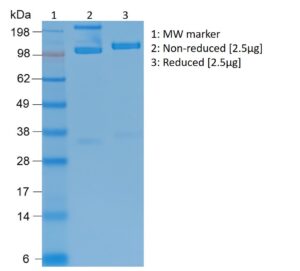
SDS-PAGE: showing non-reduced and reduced MERS-CoV spike protein.
MERS Coronavirus Spike Glycoprotein (S1), Camel Fc-Tag (HEK293)
$711.87 excl. VAT
MERS Coronavirus Spike (S1) glycoprotein, a recombinant protein with N-terminal camel Fc-tag, manufactured in mammalian HEK293 cells.
MERS CORONAVIRUS SPIKE GLYCOPROTEIN (S1)
MERS Coronavirus Spike (S1), a recombinant protein with N-terminal camel Fc-tag, manufactured in mammalian HEK293 cells.
PRODUCT DETAILS – MERS CORONAVIRUS SPIKE (S1)
- Recombinant MERS-CoV Spike protein fused to a camel Fc-tag.
- Protein was produced in mammalian HEK293 cells.
- Presented as liquid in PBS.
BACKGROUND
Middle East respiratory syndrome-related coronavirus (MERS-CoV) is a positive-sense, single-stranded RNA virus of the genus Betacoronavirus (group C lineage). The genome encodes at least 10 open reading frames (ORFs), nine of which are expressed from seven subgenomic mRNAs (sg mRNAs), which are then translated into four major viral structural proteins, including spike (S), envelope (E), membrane (M), and nucleocapsid (N), as well as several accessory proteins, such as 3, 4a, 4b, 5, and 8b with unknown origins and functions (Du et al., 2016).
The spike (S) glycoprotein is responsible for receptor binding and subsequent viral entry into host cells, and it is, therefore, a major therapeutic target and primary target for neutralizing antibodies. It contains protrusions that will only bind to certain receptors on the host cell which are essential for both host specificity and viral infectivity. It is also a major immunogen and a target for entry inhibitors. The SARS-CoV spike (S) protein is composed of two subunits; the S1 subunit contains a receptor-binding domain that engages with the host cell receptor angiotensin-converting enzyme 2 and the S2 subunit mediates fusion between the viral and host cell membranes. The S protein plays key parts in the induction of neutralizing-antibody and T-cell responses, as well as protective immunity, during infection with SARS-CoV. During the infection process, the S protein of MERS-CoV is cleaved into a receptor-binding subunit S1 and a membrane-fusion subunit S2 (Du et al., 2016). The S1 subunit has been the focus of most immunization strategies against MERS-CoV, as it contains the receptor-binding domain (RBD) that mediates virus attachment to its host receptor, dipeptidyl peptidase-4 (DPP4) (Wang et al., 2015). Specific targets in the S protein include N-terminal domain (NTD), RBD and other regions in S1 subunit, and HR1 and HR2 in S2 subunit, as well as other targets related to the function of MERS-CoV S protein (Du et al., 2016).
MERS-CoV is one of several viruses identified by WHO as a likely cause of a future epidemic and is listed for urgent research and development. The high case fatality rate, vaguely defined epidemiology, and absence of prophylactic or therapeutic measures against this novel virus have created an urgent need for an effective vaccine should an outbreak expand to pandemic proportions. Immunogens based on full-length Spike DNA and S1 subunit protein have been shown to elicit robust serum-neutralizing activity against several MERS-CoV strains in mice and non-human primates (Wang et al., 2015). In indirect ELISAs, MERS-CoV spike (S) ectodomain (amino acids 1-1297) and S1 subunit (amino acids 1-725) showed higher sensitivity and specificity (≥90%) than nucleocapsid protein (N), and showed better agreement and correlation with microneutralization assayS. The Spike protein therefore represents a good choice for seroepidemiological testing and surveillance in MERS-CoV endemic regions.
References
- Du et al. (2016). MERS-CoV spike protein: a key target for antivirals. Expert Opin Ther Targets. 21(2):131-143. PMID: 27936982
- Wang et al. (2015). Evaluation of candidate vaccine approaches for MERS-CoV. Nat Commun. 28;6:7712. PMID: 26218507
- Al-Amri et al. (2017). Immunogenicity of Candidate MERS-CoV DNA Vaccines Based on the Spike Protein. Sci Rep. 23;7:44875. PMID: 28332568
- Hashem et al (2019). Development and validation of different indirect ELISAs for MERS-CoV serological testing. J Immunol Methods. 466:41-46. PMID: 30659836

